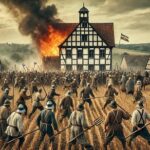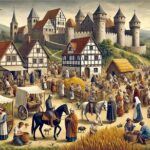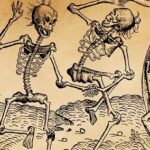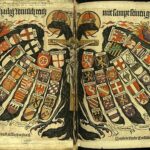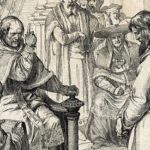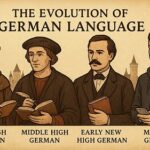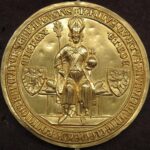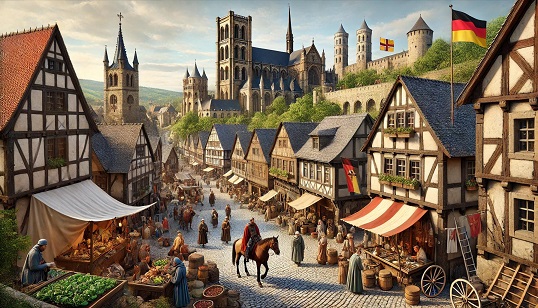
Picture a castle perched high on a misty hill, knights in chainmail clanking through narrow village streets, and monks illuminating manuscripts in candlelit scriptoriums. Welcome to The Middle Ages in German History, a time of feudal lords, imperial ambitions, epic poetry, and brewing revolts. Far from being a dark age, this period laid the foundations for modern Europe and gave rise to Germany’s most iconic cultural and political structures.
This page explores the Middle Ages not as a footnote in history but as a central era in the shaping of German identity. From the tribal roots of the early medieval kingdoms to the grandiose reign of the Holy Roman Emperors, this category is your guide to one of Germany’s most fascinating and formative historical chapters.
Overview
The Middle Ages in German history (roughly 500–1500 CE) spans a full millennium of transformation. It begins with the fall of the Western Roman Empire and continues through the Carolingian Renaissance, the height of the Holy Roman Empire, the rise of knightly culture, and the birth of universities and towns. It ends at the doorstep of the Reformation.
In this age, German lands were not a single country but a web of duchies, bishoprics, and imperial cities. The cultural and political diversity of the region gave rise to local dynasties, powerful guilds, and some truly breathtaking architecture—from Romanesque cathedrals to Gothic castles. This category brings you into that world, explaining the institutions, daily life, and key figures who made the medieval German-speaking lands what they were.
The Rise of the Holy Roman Empire
After the crowning of Charlemagne in 800 CE, German kings played a central role in what would become the Holy Roman Empire—a unique blend of Roman legacy and German ambition.
- Charlemagne and the Carolingian Dynasty
- The Holy Roman Empire: Structure and Legacy
- Otto the Great and the Rise of the Ottonian Dynasty
Feudalism, Nobility, and Knighthood
Medieval Germany was built on a feudal system that organized society through bonds of loyalty and service. Learn about the roles of lords, vassals, and knights—and how the famous Minnesänger added a poetic touch to chivalric life.
Church Power and Religious Conflicts
Religion shaped every aspect of medieval life—from the legitimacy of rulers to public festivals. Dive into the power struggles between emperors and popes and the pivotal events that defined ecclesiastical authority in Germany.
Cities, Guilds, and Everyday Life
As trade grew, so did cities. From Lübeck to Nuremberg, German towns flourished with merchant wealth and artisan skill. Explore medieval urban life, market laws, and the powerful rise of guilds.
Crises, Conflict, and Change
It wasn’t all castles and chivalry. The Middle Ages also witnessed plagues, revolts, and brutal frontier campaigns. These moments of crisis dramatically altered the social and political fabric of medieval Germany.
- The Black Death in Germany
- Peasant Revolts in the Middle Ages
- The Teutonic Knights and Eastern Expansion
Monasteries and Medieval Learning
Long before Google, monasteries were the keepers of knowledge. Discover how monastic life shaped culture, preserved texts, and promoted early education throughout German territories.
Cultural Significance and Practical Applications
The legacy of the German Middle Ages is everywhere: in cathedral spires that pierce modern skylines, in festivals that reenact knightly tournaments, and in legal traditions that echo medieval codes.
Walk through the Altstadt of Rothenburg ob der Tauber or explore the Romanesque crypt of Speyer Cathedral and you’re stepping into history. The architecture, language (hello, Middle High German!), and even culinary traditions like Lebkuchen have medieval roots.
For travelers, history buffs, or literature lovers diving into the Nibelungenlied, the Middle Ages aren’t a distant past—they’re an ever-present cultural touchstone. Studying this era provides context for everything from Germany’s federal structure to its love of Ordnung and local identity.
Understanding medieval history also enriches modern interpretations of justice, governance, and art. From Germany’s tradition of civic autonomy rooted in medieval free cities, to the lingering symbolic power of the imperial crown, echoes of the Middle Ages resonate in law, politics, and cultural identity today. Even pop culture—from medieval markets to reenactment festivals—draws heavily on imagery born in this era.
The Middle Ages in German history is more than chainmail and castles—it’s a story of transformation, resilience, and rich cultural development. This era saw the rise of empires, the birth of cities, and the beginnings of modern institutions.
Whether you’re here to explore Gothic cathedrals, trace medieval dynasties, or simply wander the cobblestone lanes of the past, this category is your portal into a thousand years of German history. Dive in, and you may never look at a timber-framed house or stone tower the same way again.
Explore the fascinating world of The Middle Ages in German History and discover how it continues to shape Germany today. Click into our featured articles and go deeper!
Otto I and the Birth of the Holy Roman Empire – Explore how Otto I’s coronation in 962 marked the formal beginning of the Holy Roman Empire, establishing a powerful political and religious legacy in medieval Germany.
Medieval German Feudal Society – Learn how landholding, loyalty, and class defined the social structure of medieval Germany, shaping both everyday life and royal authority.
The Hanseatic League – Discover the rise of this powerful trade alliance of northern German cities that dominated commerce across the Baltic and North Seas during the late Middle Ages.
German Castles and Knightly Culture – Dive into the architectural and chivalric world of medieval Germany, where fortified castles and knightly ideals shaped warfare, literature, and noble identity.
The Investiture Controversy – A pivotal power struggle between church and state, this conflict reshaped the relationship between emperors and popes across the German medieval landscape.
The Black Death in Germany – Trace the devastating impact of the 14th-century plague on German towns and villages, altering demographics, labor systems, and religious life.
Peasant Revolts in the Middle Ages – Examine the causes and consequences of peasant uprisings in medieval Germany, including their role in challenging feudal oppression and economic hardship.
The Teutonic Knights and Eastern Expansion – Follow the military and missionary campaigns of the Teutonic Order as they expanded Germanic influence eastward into pagan territories.
German Medieval Universities – Explore the intellectual revival of the High Middle Ages, as cathedral schools and universities flourished in German cities, preserving classical knowledge and fostering new ideas.
The Golden Bull of 1356 – Understand the constitutional landmark that formalized the election of German kings, shaping imperial governance in the Holy Roman Empire for centuries.
